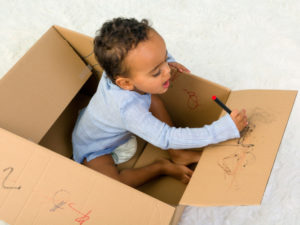How important is it for me to bring my child to occupational therapy – it seems like all he does is play.
I have very mixed feelings when I hear this comment from parents. On one hand, the fact that it looks like “just play” means that the child and the therapist have bonded. On the other hand, this also means that I have not done my job properly to explain to the parent how each aspect of “play” is actually therapy and how each of these play activities is actually helping the child become more independent. So, I am taking the time here to explain how play is not just “play”.
Pairing
Whether you call it bonding, pairing, establishing rapport, or simply learning to like each other, this step is a crucial first step to any therapeutic treatment plan. It involves pairing yourself with items and activities the child loves. I have a quote up on my wall at work:
“Kids don’t learn from people they don’t like.” (Rita Pierson – an educator of 40 years)
True, right? Some children warm up in just a few minutes. Other children are a bit more skeptical of this goofy adult suddenly trying to interact with them, and these children may take several sessions in order to warm up to their therapist. My personal therapy practice tends to be with the kiddos who are of the skeptical and anxious variety. And, when they DO learn to have fun with you…. oooh, that’s the good stuff. That is when the magic happens. That is when the child can truly make progress toward whatever therapy goals he/she has.
If you have not established rapport first, all other treatment goals might as well not even exist. THIS is the crucial part of any therapy program, any classroom, and quite frankly any relationship.
Occupational Therapy Play
Over a decade ago, when I was a relatively new grad, I read The Sensory Sensitive Child. In this book, a description on how to find a good OT for your child is given. This book’s advice: If it looks like the child is simply having fun with a very playful adult, then you have found the right therapist. I think of this advice multiple times per day. What is the occupation of a child? To play, right? Children need to have fine motor strength and coordination in order to play. In addition, children need to be able to sit at the table and engage in handwriting and other academic work, learn to tie their shoes, button their shirts, etc. The play part is fun. But the handwriting and tying shoes part can be boring. Therefore, a good OT will always have a mixture of the playful and the more “work-oriented” tasks.
In addition, most OT’s (and PT’s and ST’s) work under the theory of sensory integration. This involves engaging the child in a series of activities (jumping, swinging, heavy work, etc.) in order to make sure that the child is ready to learn. If a child is bouncing off the walls, he can’t learn. If a child is half asleep, he can’t learn. Sensory integration activities ensure that the child is in the optimum state of alertness to be ready learn, so that you can both make the best use of his therapy minutes.
Physical Therapy Play
What is the goal of most pediatric physical therapy treatment plans? For the child to have the strength and coordination to run, jump, and play, right? What child actually says, “Hmmm… I think some sit-ups sound fun today”? Very, very few. While a certain amount of rote exercise is necessary, you will motivate a child much more if you can incorporate those exercises into a game, on a swing, in an obstacle course, with a puzzle, etc. Throw in Nerf gun target practice, and just watch how much more motivated that child is to do their exercises! Yes, it all looks like simple play, but so much of getting a child to engage in “boring exercises” is to ensure that the exercises are NOT boring!
Speech Therapy Play
What is the goal of most speech therapy treatment plans? To talk/communicate effectively with their mama, daddy, siblings, family members, friends, and to have the proper social skills to make and maintain friendships. Therefore, a major component of many speech therapy treatment plans is to practice being friends. To practice playing and being friendly in a controlled environment with a loving therapist who will not judge mistakes. In this controlled play environment, the therapist can gently work on the missing splinter skills – vocabulary, requesting, commenting, sentence structure, social language, questioning skills, problem-solving, etc. All of this is largely done through play!
So the next time you think we are simply playing with your child – thank you! We are doing our job right! But then, please, please, please, ask us what specific skills all of this playing is addressing. Don’t worry. There is a purpose to all of this play, and we are more than happy to discuss all of the medical and therapy jargon. (But… shhhhh… let your kiddo still think it is “just play”!)
Look forward to future blog topics on play in pediatric therapy on our TEAM Blog… I’m just getting started!

